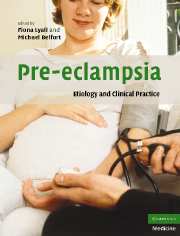Book contents
- Frontmatter
- Contents
- List of contributors
- Preface
- Part I Basic science
- Part II Clinical Practice
- 17 Classification and diagnosis of pre-eclampsia
- 18 Measuring blood pressure in pregnancy and pre-eclampsia
- 19 Immune maladaptation in the etiology of pre-eclampsia; an updated epidemiological perspective
- 20 Genetics of pre-eclampsia and counseling the patient who developed pre-eclampsia
- 21 Thrombophilias and pre-eclampsia
- 22 Medical illness and the risk of pre-eclampsia
- 23 The kidney and pre-eclampsia
- 24 Management of mild pre-eclampsia
- 25 Management of severe pre-eclampsia
- 26 The differential diagnosis of pre-eclampsia and eclampsia
- 27 Complications of pre-eclampsia
- 28 Central nervous system findings in pre-eclampsia and eclampsia
- 29 Pathogenesis and treatment of eclampsia
- 30 Anesthesia for the pre-eclamptic patient
- 31 Critical care management of severe pre-eclampsia
- 32 The role of maternal and fetal Doppler in pre-eclampsia
- 33 Pregnancy-induced hypertension – the effects on the newborn
- 34 Medico-legal implications of the diagnosis of pre-eclampsia
- Subject index
- References
19 - Immune maladaptation in the etiology of pre-eclampsia; an updated epidemiological perspective
from Part II - Clinical Practice
Published online by Cambridge University Press: 03 September 2009
- Frontmatter
- Contents
- List of contributors
- Preface
- Part I Basic science
- Part II Clinical Practice
- 17 Classification and diagnosis of pre-eclampsia
- 18 Measuring blood pressure in pregnancy and pre-eclampsia
- 19 Immune maladaptation in the etiology of pre-eclampsia; an updated epidemiological perspective
- 20 Genetics of pre-eclampsia and counseling the patient who developed pre-eclampsia
- 21 Thrombophilias and pre-eclampsia
- 22 Medical illness and the risk of pre-eclampsia
- 23 The kidney and pre-eclampsia
- 24 Management of mild pre-eclampsia
- 25 Management of severe pre-eclampsia
- 26 The differential diagnosis of pre-eclampsia and eclampsia
- 27 Complications of pre-eclampsia
- 28 Central nervous system findings in pre-eclampsia and eclampsia
- 29 Pathogenesis and treatment of eclampsia
- 30 Anesthesia for the pre-eclamptic patient
- 31 Critical care management of severe pre-eclampsia
- 32 The role of maternal and fetal Doppler in pre-eclampsia
- 33 Pregnancy-induced hypertension – the effects on the newborn
- 34 Medico-legal implications of the diagnosis of pre-eclampsia
- Subject index
- References
Summary
Introduction
Shallow, endovascular cytotrophoblast invasion in the spiral arteries and endothelial cell dysfunction are two key features in the pathophysiology of pre-eclampsia (Roberts and Redman, 1993). However, the cause of pre-eclampsia remains unknown. In humans, organ transplants will be rejected if there are differences between donor and recipient with respect to histocompatibility complex genes, i.e. human leukocyte antigens. The feto-placental unit contains paternal antigens that are foreign to its maternal host. The concept that pre-eclampsia may be an immunologic disorder dates back to the beginning of the century (McQuarrrie, 1923; Medawar, 1953; Scott and Beer, 1976; Veit, 1902). In the early 1950s, Medawar (1953) proposed the concept of the “fetus as an allograft.” Since then it has been assumed that implantation of the fetal placenta would be controlled by a maternal immune response mediated by T cells recognizing paternally derived allo-antigens expressed by the placenta. Ongoing research in the last decade has shown that implantation might predominantly involve a novel allogenetic recognition system based on natural killer cells rather than T cells. Dr. Ashley Moffett's chapter provides a detailed overview of our current understanding on the immune biology and immune pathology of placentation as it relates to pre-eclampsia, with a focus on the important role of NK-cells.
In this chapter we aim to provide an up-to-date review on epidemiologic studies corroborating or refuting the hypothesis that maladaptation between the maternal immune system and the feto-placental allograft is involved in the etiology of pre-eclampsia.
- Type
- Chapter
- Information
- Pre-eclampsiaEtiology and Clinical Practice, pp. 276 - 294Publisher: Cambridge University PressPrint publication year: 2007



